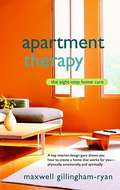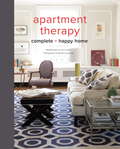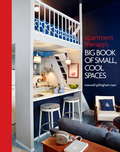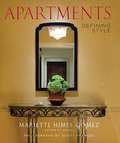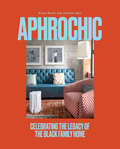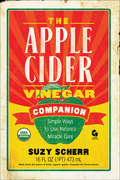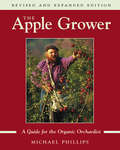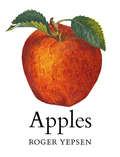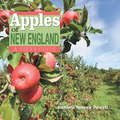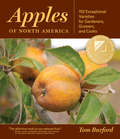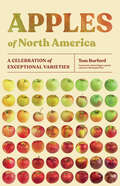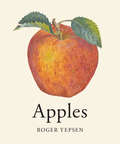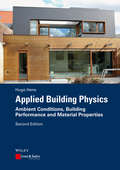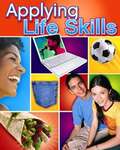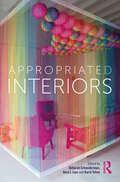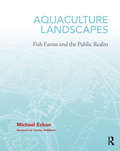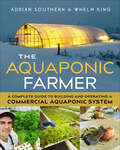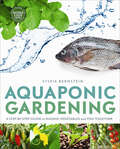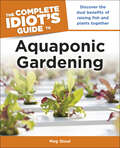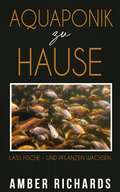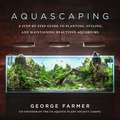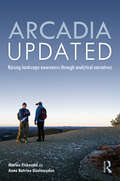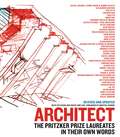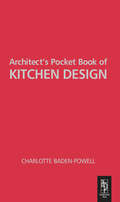- Table View
- List View
Apartment Therapy: The Eight-Step Home Cure
by Maxwell Gillingham-RyanFrom not enough space and too many things to not knowing what color to paint the living room walls, many of us struggle with our homes. Now Maxwell Gillingham-Ryan, frequent makeover expert on HGTV’s Mission: Organization and Small Spaces, Big Style, shares the do-it-yourself strategies that have enabled his clients and fans to transform their apartments into well-organized, beautiful places that suit their style and budget. Week by week,Apartment Therapywill guide you to treat common problems, eliminate clutter, and revamp even the tiniest space. Here is an eight-step process that includes: A therapeutic questionnaire to help you get in touch with your personal taste and diagnose your home’s physical, emotional, and energy flow issues A prescription with recommendations for each room based on your needs and lifestyle–including tips on how to use color, lighting, and accessories A treatment plan, including regular maintenance schedules to ensure the ongoing health of your space Illustrations of floor plans and decorative examples that allow you to visualize concepts before you begin With surprising ease and without elaborate professional help,Apartment Therapywill help you clear a path through disorder and indecision–to reveal a home you’ll love. From the Trade Paperback edition.
Apartment Therapy Complete and Happy Home
by Maxwell Ryan Melanie Acevedo Janel LabanThe most comprehensive and complete home book from Apartment Therapy, featuring every aspect of design and decorating from floor plans to paint, specific rooms to style approaches, with the goal of setting up and living well in a place you love. "A complete and happy home is so much more than a series of pretty rooms. Between these two covers, we've captured everything we've learned at Apartment Therapy about decorating, organizing, cleaning, and repairs, so you can make and maintain your own fabulous home." --from the IntroductionGetting a room to feel right is more instinct than science. You know a great space when you see it. Apartment Therapy trains your eye with more than 75 rooms, from bedrooms to kitchens and living rooms to kids' rooms and workspaces. Explore every detail--lighting, color palettes, flooring, and accessories--that brings a home to life and, most important, makes you happy in it.
Apartment Therapy's Big Book of Small, Cool Spaces
by Maxwell RyanWhether you inhabit a studio or a sprawling house with one challenging space, Maxwell Gillingham-Ryan, co-founder of the most popular interior design website, Apartment Therapy, will help you transform tiny into totally fabulous. According to Maxwell, size constraints can actually unlock your design creativity and allow you to focus on what's essential. In this vibrant book, he shares forty small, cool spaces that will change your thinking forever. These apartments and houses demonstrate hundreds of inventive solutions for creating more space in your home, and for making it more comfortable. Leading us through entrances, living rooms, kitchens and dining rooms, bedrooms, home offices, and kids' rooms, Apartment Therapy's Big Book of Small, Cool Spaces is brimming with ingenious tips and ideas, such as: * Shifting the sense of scale through contrasting colors* Adding airiness by using transparent collections * Utilizing the area under a loft bed for a kitchen and mini-bar * Tucking an office with chic vintage doors into an unused bedroom corner In each dwelling Maxwell points out what makes the layout work and what adds style. Most of the "therapy" involves minor tweaks that can be accomplished on a limited budget, such as dividing a room with sheer curtains, turning a door into a desk, or disguising electrical boxes with art displays. An extensive resource guide, including Maxwell's favorite websites for buying desks, open storage solutions, and much more, will help you turn even the tiniest residence into a place you are always happy to come home to. From the Hardcover edition.
Apartments
by Mariette Himes GomezThe award-winning designer and author of Rooms and Houses returns with inspiring ideas for apartment interiors in this lavishly photographed book. Step into a space designed by Mariette Himes Gomez and you're sure to notice the refined simplicity, clear architectural composition, and thoughtful attention to detail that have made her one of the most respected and sought-after tastemakers in the country. In Apartments, Gomez divulges the secrets of the trade to help you transform even the smallest pied-À-terre into a chic and airy living space. Filled with breathtaking photography, Apartments offers a stunning visual tour of her most elegant designs. Gomez works with the natural composition of her clients' apartments to highlight each room's assets--such as a Central Park view--and address its deficits, such as the remnants of a previous owner's paint job. From the placement of an antique French cabinet in a 1920s Rosario Candela apartment in New York City to the replacement of mirrored walls in an oceanside deck in Palm Beach, Gomez provides practical suggestions for building, buying, or renovating to create the perfect space. Subscribing to the philosophy that less is more, she reveals how the elements of balance, color, and movement instill flow and harmony in any design. Whether you are decorating a modest studio or a palatial penthouse suite, Apartments illuminates the world of possibility that unfolds when you let your apartment become your home.
AphroChic: Celebrating the Legacy of the Black Family Home
by Jeanine Hays Bryan MasonA powerful, visually stunning celebration of Black homeownership, featuring inspiring homes and family histories of notable Black Americans—including chef Alexander Smalls and actor Danielle Brooks.&“The most important design book of our time.&”—Stacey Lindsay, design editor, Camille StylesJeanine Hays and Bryan Mason invite you into the intimate spaces of actors and musicians, the creative studios of artists and curators, the &“boss&” homes of entrepreneurs and executives, &“off-the-beaten-path&” homes that defy the stereotypes of urban living, and places filled with pieces handed down from generations past. Tour the creative and culturally infused Washington, DC, rowhouse of author Jason Reynolds. Take in the bursts of color and layers of memory that fill the Harlem Renaissance–inspired interior of renowned chef Alexander Smalls. And get inspired by the design of actor Danielle Brooks and her husband Dennis Gelin&’s Brooklyn townhome, where Haitian heritage and South Carolina roots meet. Showcasing the amazing diversity of the Black experience through striking interiors, stories of family and community, and histories exploring the obstacles Black homeowners have faced for generations, this groundbreaking book honors the journey, recognizes the struggle, and celebrates the joy that is the Black family home.
The Apple Cider Vinegar Companion: Simple Ways to Use Nature's Miracle Cure
by Suzy ScherrThe multitasking superfood is delicious, too! Generations of devotees have sworn by apple cider vinegar: cooking with it, swigging it by the spoonful, and using it as a remedy for just about any ailment. Why? The tart, fermented flavor certainly can add a punch to any recipe, but it’s also great for weight-loss, digestion, and overall good health. It makes a mean natural cleanser, relieves muscle soreness, and even treats bug bites. The Apple Cider Vinegar Companion is the essential guide, with information on how to make your own, and tips and tricks for using it for household tasks. This book stands out from similar titles because of the wonderful recipes, such as: Dill Pickle Potato Salad Easy Homemade Farmer’s Cheese Homemade Spiced Ketchup Raspberry-Peach Shrub Green Tea and Apple Cider Vinegar Tonic
The Apple Grower
by Michael PhillipsThe definitive guide to growing apples wisely, naturally, and with gentle impact on the earth. For decades fruit growers have sprayed their trees with toxic chemicals in an attempt to control a range of insect and fungal pests. Yet it is possible to grow apples responsibly, by applying the intuitive knowledge of our great-grandparents with the fruits of modern scientific research and innovation. Since "The Apple Grower" first appeared in 1998, orchardist Michael Phillips has continued his research with apples, which have been called "organic's final frontier. " In this new edition of his widely acclaimed work, Phillips delves even deeper into the mysteries of growing good fruit with minimal inputs. Some of the cutting edge topics he explores include: bull; The use of kaolin clay as an effective strategy against curculio and borers, as well as its limitations bull; Creating a diverse, healthy orchard ecosystem through understory management of plants, nutrients, and beneficial microorganisms bull; How to make a small apple business viable by focusing on heritage and regional varieties, value-added products, and the "community orchard" model The author's personal voice and clear-eyed advice have already made "The Apple Grower" a classic among small-scale growers and home orchardists. In fact, anyone serious about succeeding with apples needs to have this updated edition on their bookshelf.
Apples
by Roger YepsenIn this small and elegant book, artist/writer Roger Yepsen presents fascinating facts about more than 200 varieties of apples growing in the United States. With beautiful and distinctive watercolors, he makes identification a snap. He also reveals how each variety tastes and which varieties are best for eating and cooking.
Apples of New England: A User's Guide
by Russell PowellA guide to more than 200 varieties of apples! This fascinating and helpful guide will offer practical advice about rare heirlooms and newly discovered varieties, chapters on the rich tradition of apple growing in New England and on the "fathers" of American apples--Massachusetts natives John Chapman ("Johnny Appleseed") and Henry David Thoreau. Apples of New England will present the apple in all its splendor: as biological wonder, super food, work of art, and cultural icon. Apples of New England will be an indispensable resource for anyone identifying apples in New England orchards, farm stands, grocery stores--or their own backyard. Photographs of the more than 200 apples discovered, grown, or sold in New England will be accompanied by notes about flavor and texture, history, ripening time, storage quality, and best use.
Apples of North America: Exceptional Varieties for Gardeners, Growers, and Cooks
by Tom BurfordAmerican Horticulture Society Award Winner The apple is one of the most iconic fruits, traditionally picked on cool fall days and used in pies, crisps, and ciders. And there is a vast world of varieties that goes beyond the common grocery store offerings of Red Delicious and Granny Smith. With names like American Beauty, Carter’s Blue, and Fallawater, and flavors ranging from sweet to tart, this treasure trove of unique apples is ripe for discovery. There is no better guide through this tasty world than Tom Burford, whose family has grown apples in the Blue Ridge Mountains since 1715. The book is brimming with beautiful portraits of heirloom and modern apples of merit, each accompanied by distinguishing characteristics and common uses. As the view broadens to the orchard, you will find information on planting, pruning, grafting, and more. The exploration of the apple culminates with an overview of the fruit’s transformative capabilities when pressed, fermented, cooked, or dried. Beyond the polished and predictable grocery store display of Red Delicious and Granny Smith apples, a feast of beautiful and uniquely flavored North American varieties awaits the curious.
Apples of North America: A Celebration of Exceptional Varieties
by Tom Burford&“For all of us who cherish the apple, its utility, its flavors, and its powers of revelation and connection.&” —Adrian Higgins, garden columnist, The Washington Post The apple is one of the most iconic fruits, traditionally picked on cool fall days and used in pies, crisps, ciders, and more. And there is a vast world of varieties that goes well beyond the common grocery store offerings. With names like American Beauty, Carter&’s Blue, and Fallawater, and flavors ranging from sweet to tart, this treasure trove of unique apples is ripe for discovery. There is no better guide through this tasty world than Tom Burford, whose family has grown apples in the Blue Ridge Mountains since 1715. His celebratory book Apples of North America is brimming with beautiful portraits of heirloom and modern apples of merit, each accompanied by distinguishing characteristics and common uses. You will also find information on growing apples at home—with specifics on planting, pruning, grafting, and more—and instructions on how to preserve apples through pressing, fermenting, cooking, and drying.
Apples (Revised and Updated)
by Roger Yepsen90 beautifully illustrated common and rare apples from the orchards of North America. Roger Yepsen knows his apples. He should, as he is a seasoned orchardist as well as a talented writer and illustrator. Here he presents fascinating facts about 90 mainstay and unusual varieties of apples grown in the United States, from Red Delicious and Granny Smith to Knobbed Russet and Hubbardston Nonesuch. Each entry identifies the variety’s harvest season, unique taste,and best uses, and Yepsen’s beautiful and distinctive watercolors make identification a snap. This new edition has been updated with entries on Honeycrisp and other varieties that have becomes popular since the first publication of Apples in 1994. But this is not just a grower’s catalog. Yepsen also includes a brief history of apples in North America, and recipes for pies, sauces, ciders, and more.
Applied Building Physics: Ambient Conditions, Building Performance and Material Properties
by Hugo S. HensBad experiences with construction quality, the energy crises of 1973 and 1979,complaints about `sick buildings?, thermal, acoustical, visual and olfactory discomfort, the need for good air quality, the move towards more sustainability ? all these have accelerated the development of a field that, for a long time, was hardly more than an academic exercise: building physics. The discipline embraces domains such as heat and mass transfer, building acoustics, lighting, indoor environmental quality and energy efficiency. In some countries, fire safety is also included. Through the application of physical knowledge and its combination with information coming from other disciplines, the field helps to understand the physical phenomena governing building parts, building envelope, whole building and built environment performance, although for the last the wording `urban physics? is used. Building physics has a real impact on performance-based building design. This volume on `Applied Building Physics? discusses the heat, air and moisture performance metrics that affect building design, construction and retrofitting.
Applying Life Skills (Eighth Edition)
by Joan Kelly-Plate Eddye EubanksApplying Life Skills, formerly known as Today's Teen, is a major revision of this hands-on comprehensive Family & Consumer Sciences program. This new edition blends a practical, hands-on approach with a fresh new design, interesting features, and new photographs to enhance readability and promote learning. Students will learn and apply essential life skills.
Appropriated Interiors
by Deborah Schneiderman Anca I. Lasc Karin TehveAppropriated Interiors uncovers the ways interiors participate explicitly and implicitly in embedded cultural and societal values and explores timely emergent scholarship in the fields of interior design history, theory, and practice. What is "appropriate" and "inappropriate" now? These are terms with particular interest to the study of the interior. Featuring thirteen original curated essays, Appropriated Interiors explores the tensions between normative interiors that express the dominant cultural values of a society and interiors that express new, changing, and even transgressive values. With case studies from the late eighteenth century to the twenty-first century, these historians, theorists, and design practitioners investigate the implications of interior design as it relates to politics, gender, identity, spatial abstraction, cultural expression, racial expression, technology, and much more. An informative read for students and scholars of design history and theory, this collection considers the standards, assumptions, codes, and/or conventions that need to be dismantled and how we can expand our understanding of the history, theory, and practice of interior design to challenge the status quo.
Aquaculture Landscapes: Fish Farms and the Public Realm
by Michael EzbanAquaculture Landscapes explores the landscape architecture of farms, reefs, parks, and cities that are designed to entwine the lives of fish and humans. In the twenty-first century, aquaculture’s contribution to the supply of fish for human consumption exceeds that of wild-caught fish for the first time in history. Aquaculture has emerged as the fastest growing food production sector in the world, but aquaculture has agency beyond simply converting fish to food. Aquaculture Landscapes recovers aquaculture as a practice with a deep history of constructing extraordinary landscapes. These landscapes are characterized and enriched by multispecies interdependency, performative ecologies, collaborative practices, and aesthetic experiences between humans and fish. Aquaculture Landscapes presents over thirty contemporary and historical landscapes, spanning six continents, with incisive diagrams and vivid photographs. Within this expansive scope is a focus on urban aquaculture projects by leading designers—including Turenscape, James Corner Field Operations, and SCAPE—that employ mutually beneficial strategies for fish and humans to address urban coastal resiliency, wastewater management, and other contemporary urban challenges. Michael Ezban delivers a compelling account of the coalitions of fish and humans that shape the form, function, and identity of cities, and he offers a forward-thinking theorization of landscape as the preeminent medium for the design of ichthyological urbanism in the Anthropocene. With over two hundred evocative images, including ninety original drawings by the author, Aquaculture Landscapes is a richly illustrated portrayal of aquaculture seen through the disciplinary lens of landscape architecture. As the first book devoted to this topic, Aquaculture Landscapes is an original and essential resource for landscape architects, urbanists, animal geographers, aquaculturists, and all who seek and value multispecies cohabitation of a shared public realm.
The Aquaponic Farmer: A Complete Guide to Building and Operating a Commercial Aquaponic System
by Adrian Southern Whelm King&“The essential guide for people serious about setting up a commercial, cold-water aquaponic system.&” —Dr. Daniel Baker, Department of Fisheries and Aquaculture, Vancouver Island University Profitable cold-water fish and vegetable production. Join the aquaponic farming revolution! Built around a proven 120&’ greenhouse system operable by one person, The Aquaponic Farmer is the game changer that distills vast experience and complete step-by-step guidance for starting and running a cold-water aquaponic farming business—raising fish and vegetables together commercially. Coverage includes: A primer on cold-water aquaponics Pros and cons of different systems Complete design and construction of a Deep Water Culture system Recommended and optional equipment and tools System management, standard operating procedures, and maintenance checklists Maximizing fish and veg production Strategies for successful sales and marketing of fish and plants. As the only comprehensive commercial cold-water resource, The Aquaponic Farmer is essential for farmers contemplating the aquaponics market, aquaponic gardeners looking to go commercial, and anyone focused on high quality food production. Aquaponic farming is the most promising innovation for a sustainable, profitable, localized food system. Until now, systems have largely focused on warm-water fish such as tilapia. A lack of reliable information for raising fish and vegetables in the cool climates of North America and Europe has been a major stumbling block. The Aquaponic Farmer is the toolkit you need. &“Provides almost a step by step cookbook on all pertinent aspects of aquaponics and is based upon the authors&’ experiences from their own successful farm.&” —Michael B. Timmons, PhD & PE, Professor Biological & Environmental Engineering, Cornell University
Aquaponic Gardening: A Step-by-Step Guide to Raising Vegetables and Fish Together (Mother Earth News Books for Wiser Living)
by Sylvia Bernstein&“I have always wanted to figure out how to do sustainable aquaculture in the context of my home garden. Finally I&’ve got the book to help me do it.&” —Paul Greenberg, New York Times–bestselling author, Four Fish: The Future of the Last Wild Food Aquaponics is a revolutionary system for growing plants by fertilizing them with the waste water from fish in a sustainable closed system. A combination of the best of aquaculture and hydroponics, aquaponic gardening is an amazingly productive way to grow organic vegetables, greens, herbs and fruits, while providing the added benefits of fresh fish as a safe, healthy source of protein. On a larger scale, it is a key solution to mitigating food insecurity, climate change, groundwater pollution and the impacts of overfishing on our oceans.Aquaponic Gardening is the definitive do-it-yourself home manual, focused on giving you all the tools you need to create your own aquaponic system and enjoy healthy, safe, fresh and delicious food all year round. Starting with an overview of the theory, benefits and potential of aquaponics, the book goes on to explain: System location considerations and hardware components The living elements—fish, plants, bacteria, and worms Putting it all together—starting and maintaining a healthy system. Aquaponics systems are completely organic. They are four to six times more productive and use 90 percent less water than conventional gardens. Other advantages include no weeds, fewer pests, and no watering, fertilizing, bending, digging, or heavy lifting—in fact, there really is no down side! Anyone interested in taking the next step towards self-sufficiency will be fascinated by this practical, accessible and well-illustrated guide. &“An excellent primer for anyone considering home-scale aquaculture.&” —Peter Bane, publisher, Permaculture Activist and author, The Permaculture Handbook
Aquaponic Gardening: Discover the Dual Benefits of Raising Fish and Plants Together (Idiot's Guides)
by Meg StoutThe Complete Idiot&’s Guide® to Aquaponic Gardening is a comprehensive guide to aquaponic gardening, from choosing a setup to selecting fish and vegetables. In addition to everything one needs to know to run a healthy aquaponic garden and care for both the vegetables and fish, there are step-by-step plans with photos for building different size systems. The expert author fully explains how to garden indoors and how to resize and move a garden inside or outside, depending on the season, to produce an abundant supply of edible, organically raised vegetables and fish.
Aquaponik zu Hause: Lass Fische - und Pflanzen wachsen
by Amber RichardsHast du dich mal gefragt, was Aquaponik eigentlich ist? Ist sie vielleicht sogar Etwas für dich? Dieses E-book gibt dir einen guten Einblick und beantwortet noch viele weitere Fragen. Die Aquaponik ist die revolutionäre Wissenschaft, bei der Pflanzen im Wasser, statt in der Erde angebaut werden. Das Wasser seinerseits beherbergt zudem Fische und andere Wasserlebewesen, die durch ihre Exkremente die Pflanzen mit den nötigen Nährstoffen versorgen. Die Pflanzen wiederum reinigen das Wasser und bilden somit eine Symbiose zwischen Fischen, Pflanzen und wichtigen Bakterien. Die Aquaponik, wenn sie richtig aufgebaut wird, erlaubt es dir, dich mit Fischen und Pflanzen, als gesunde Nahrungsquelle für den Eigenbedarf, zu versorgen. Aquaponik zu Hause ist ein Leitfaden für Einsteiger in dieses Hobby. Dir werden Grundlagen an die Hand gegeben, die dir diese wunderbare und spannende Art des Pflanzenanbaus vermitteln. Außerdem erfährst du, was du brauchst, um dein eigenes Aquaponik System zu bauen, aufzustellen, und dich somit das ganze Jahr mit gesunder, frischer und leckerer Nahrung zu versorgen. Lade dir jetzt dein Exemplar herunter.
Aquascaping: A Step-by-Step Guide to Planting, Styling, and Maintaining Beautiful Aquariums
by George FarmerLearn how to create and maintain your own underwater ecosystem. Aquascaping is the art of creating beautiful aquariums with natural materials and live plants. From the brilliance of Takashi Amano and numerous other innovators, aquascapes have become a popular way to enjoy aquariums. In Aquascaping: A Step-by-Step Guide to Planting, Styling, and Maintaining Beautiful Underwater Aquariums, planted aquarium expert George Farmer teaches how to create the perfect aquascape. Included in this book are full-color photographs that will supply readers with: Step-by-step instructions on setting up your tankDifferent styling suggestions that best suit your landscapeHow to pick plants, rocks, driftwood, substrate, and aquatic lifeUnderstanding the chemistry and biology involved in keeping a healthy aquariumMaintenance and upkeepAnd much more Creating an underwater ecosystem is not only a rewarding experience, but can bring much peace and relaxation to your life. So whether you&’re a novice aquarist or seasoned aquascaper, Aquascaping will teach you all the tricks of the trade so that your beautiful aquarium can be enjoyed by family, friends, and, most importantly, yourself.
Arabians and Other Horses (World Book's Animals of the World)
by Karen IngebretsenIn a question and answer format the author introduces the Arabian horse and also discusses caring for a horse.
Arcadia Updated: Raising landscape awareness through analytical narratives
by Marius Fiskevold Anne Katrine GeelmuydenArcadia Updated delves into the concept of landscape as it is shaped by the literary tradition and material works known as pastoral. Referring to several of the tradition’s works as well as scholarly critiques, Fiskevold and Geelmuyden highlight how individual landscape perception is primarily a cultural construct: each individual may see a unique landscape based on personal experiences, but simultaneously, landscape represents a tradition of engaging with nature and land, which has been largely forgotten. In re-engaging and connecting the practice of understanding landscapes with the pastoral tradition, the authors establish a common ground for treating landscape as an object of analysis in landscape planning. Arcadia Updated contributes to the methodological debate concerning landscape character assessment. Including 30 black-and-white images, this book analyses how humans engage with land organically, materially and communicatively. It seeks to raise landscape awareness as both an individual and a collective act of imagination. The practice of analysing landscapes is an ongoing culture of reinterpreting the land as landscape in response to society’s development and technical progress. The role of the landscape analyst is to interpret the contemporary world and offer visual explanations of it. This book will be beneficial to professional landscape planners as well as to academics and students of landscape, literature and cultural studies. It provides an essential contribution to the cross-disciplinarity of the landscape discourse.
Architect: The Pritzker Prize Laureates in Their Own Words
by Ruth Peltason Grace Ong YanIn this completely revised and up-to-date edition, the world's most accomplished architects-Gehry, Pei, Meier, Nouvel, Piano, and 37 more-express their views on creativity, inspiration, and legacy in this visually stunning, one-of-a-kind collection.The Pritzker Prize is the most prestigious international prize for architecture. Architect includes all 42 recipients of the Pritzker Prize, and captures in pictures and their own words their awe-inspiring achievements. Organized in reverse chronological order by laureate each chapter features four to six of the architect's major works, including museums, libraries, hotels, places of worship, and more. The text, culled from notebooks, interviews, articles, and speeches illuminates the architects' influences and inspirations, personal philosophy, and aspirations for his own work and the future of architecture. The book includes More than 1000 stunning photographs, blueprints, sketches, and CAD drawings.Architect offers an unprecedented view into the minds of some of the most creative thinkers, dreamers, and builders of the last three decades and reveals that buildings are political, emotional, and spiritual.
Architect's Pocket Book of Kitchen Design (Routledge Pocket Books)
by Charlotte Baden-PowellAs with the best-selling 'Architects Pocket Book' this title includes everyday information which the architect/designer normally has to find from a wide variety of sources and which is not always easily to hand.Focusing on kitchen design, this book is of use to the student as well as the experienced practitioner. It outlines all the information needed to design a workable kitchen, including ergonomics, services such as water and waste, appliances, and material choices for the floor, walls and ceiling. There is no similar compendium currently available.
